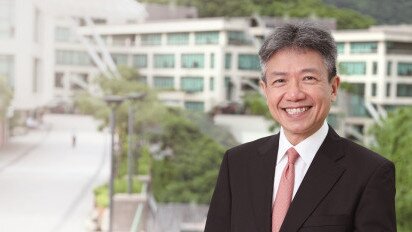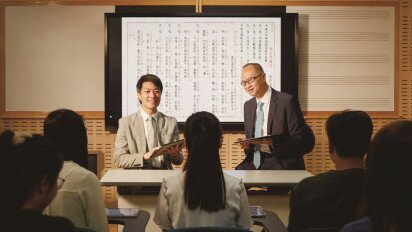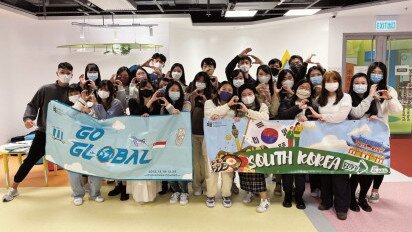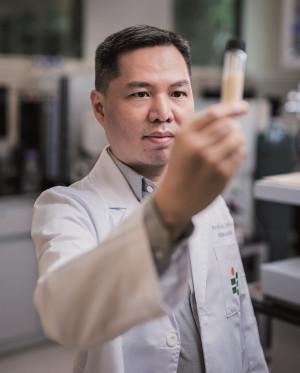
Professor Ho Wing-kei of the Department of Science and Environmental Studies has a passion for innovation but sees learning as the key to the future of mankind. As an expert in air purification, he has been awarded more than 10 patents in mainland China, Hong Kong, Europe and the United States for his innovations, and is one of the top 1% most-widely cited scientists in his field of research globally. Yet, he is driven by a humbler conviction than invention and innovation. “I’m certain the planet can be saved through education,” he says.
Triumph through perseverance
Professor Ho first fell in love with science at a young age, when doing experiments in chemistry classes at school. He was fascinated that, by following methods step-by-step, he could obtain precisely the results described in the textbook. He went on to major in chemistry at The Chinese University of Hong Kong and, as was popular at the time, volunteered for summer research projects run by different professors. These experiences laid the foundations for his future in scientific research.
University shook his preconceptions of how to conduct experiments. Suddenly, he and his fellow students did not only have to set up the experiments by themselves and account for the different environmental conditions, but also find supporting literature to prove their method was completely robust. “The experimental process is full of unknowns and it often fails, and thus needs to be done all over again,” he admits. Nevertheless, he finds it extremely rewarding when, having endured this process of trial and error, he eventually succeeds.
Research innovation and knowledge transfer
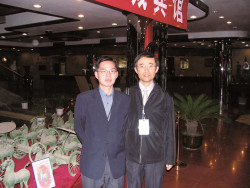
Professor Ho at an academic conference in Shanghai with his supervisor, Professor Jimmy Yu during his PhD studies at CUHK in 2004
In 2012, shortly after joining the University, Professor Ho won a Research Matching Grant from the University Grants Committee. He used it to pioneer the study of using carbon nitride to degrade air pollutants. The compound was new at the time, and rarely used for air purification.
Of course, keeping his research within the confines of a laboratory would severely limit the impact of Professor Ho’s innovation. Fortunately, he was able to tap into his experience of working for the Research and Development Centre under the Innovation and Technology Commission prior to joining the University. There, he would often be in touch with different businesses, and had to consider production costs and potential application problems when conducting research, to ensure the results reached the real world. He has since transformed this professional knowledge into practical application of his own research, in inventing the portable air purifier, winner of a Gold Award at the 2018 Innovation Competition in Canada (iCAN), and for which he has been awarded over HK$15 million in government research grants over the past 15 years.
Breaking with tradition to purify air

Conventionally, air purifiers on the market primarily use ultraviolet (UV) light and titanium dioxide photocatalytic materials to degrade air pollution. However, UV lamps have a short lifespan, are costly, and consume high levels of electricity. In contrast, Professor Ho's graphitic carbon nitride photocatalyst can use visible light as an energy source and works in daylight, indoor lighting and under LED lights, thus creating a more energy-efficient, environmentally friendly, and lightweight device. It also significantly improves the decontamination efficiency of air pollutants and of killing bacteria. It has a purification rate of up to 90% of bacteria and nitrogen oxides over the course of a year.
Widely cited
Given its results, it is unsurprising that Professor Ho's research has had a profound impact and has been widely recognised by peers both at home and abroad. In 2019, he was selected among the top 1% of the world’s most-cited scientists in a list compiled for Stanford University. The list was based on the world's largest academic database, comprising nearly 7 million scientists worldwide, and covered indicators such as total citation number and H-index. Furthermore, Professor Ho ranked in the top 1% of over 500,000 scientists in that database who specialise in the field of chemistry. That same year, he was awarded the National Innovation Award in Aerosol Technology by the Chinese Society of Particuology, in recognition of his contribution to air purification research.
Since 2018, he has also been listed by Clarivate Analytics as one of the ‘Most-cited researchers’ for five consecutive years, meaning that his annual citation rate in academic achievement ranks in the top 1% in his research field. In 2022, only around 6,000 researchers worldwide made the list.
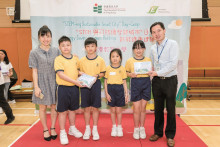
Chemistry is everywhere
Yet Professor Ho does not see such peer recognition as the be-all and end-all. While it is certainly gratifying, he feels that chemistry goes beyond academic journals, saying, “It is actually all around us in our daily lives.” He uses cooking as an example, joking that even making soup is a process of chemical extraction, as it comprises “Extracting the essence of different foods and transforming them into delicious flavours of different colours.” He also notes that the public has begun to pay attention to the chemicals used in everyday products, such as the increasing number of investigations by consumer organisations in recent years into products like shampoos, face masks, and make-up foundations.
Professor Ho did not have a background in education, and it was only in the ten years after joining EdUHK that he had the opportunity to work with colleagues in primary and secondary schools and the Education Bureau. But recently he has been actively involved in promoting STEM education, to promote the spirit of scientific inquiry on campus and to cultivate future innovative talent.
“I am committed to air purification research, in the hope of using technological innovation to study how to convert pollutants into substances which are harmless to humans, and solve the problems we encounter in our lives. However, my experience at EdUHK tells me that the best way to reduce air pollution at its source is to promote environmental and conservation education,” he says.


